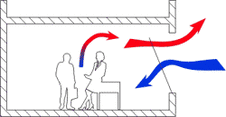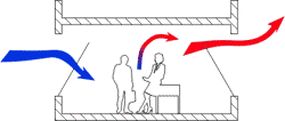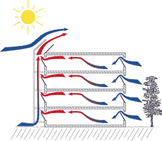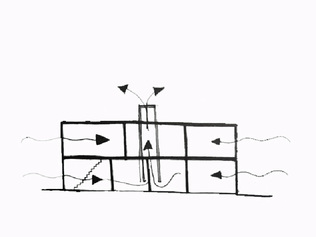NATURAL VENTILATION
FOR MORE INFORMATION REGARDING THE PRINCIPLES OF NATURAL VENTILATION PLEASE CLICK HERE.
BENEFITS:
- Improves indoor environments
- Reduces CO2 emissions
- Cost efficient, 10-30% reduction in energy consumption
- Creates a healthier working and living environment therefore improving productivity
- Much quieter than mechanical ventilation systems
- Require virtually no internal space to operate
COMMON TYPES:
NATURAL VENTILATION SYSTEMS (NVS): These can be standalone or they can be integrated into the building management system (BMS), Mittal Children’s Medical Centre has an integrated mixed mode system which allows for manual over ride to ensure the ventilation in the wards is to an appropriate comfort level for the patients. Both standalone systems and integrated systems need to be flexible and be able to be adjusted to suit the occupants changing needs.
NVS are designed to guide fresh clean air around a building, exhausting the stale air, through the intelligent use of natural forces, such as buoyancy to maintain temperature, humidity levels and comfort.
Buoyancy is a naturally occurring upwards force. It can be temperature induced, as in stack ventilation whereby the force is created when areas of low pressure suck high pressure in from the cooler outside temperatures, once sucked in, the high pressure tries to escape upwards through the building, either through the roof,or high level outlets, this means of escape of the air is known as Infiltration.
In order to create an environmentally friendly building, an Architect must integrate at least some of the aspects of natural ventilation into the building design.
NVS are designed to guide fresh clean air around a building, exhausting the stale air, through the intelligent use of natural forces, such as buoyancy to maintain temperature, humidity levels and comfort.
Buoyancy is a naturally occurring upwards force. It can be temperature induced, as in stack ventilation whereby the force is created when areas of low pressure suck high pressure in from the cooler outside temperatures, once sucked in, the high pressure tries to escape upwards through the building, either through the roof,or high level outlets, this means of escape of the air is known as Infiltration.
In order to create an environmentally friendly building, an Architect must integrate at least some of the aspects of natural ventilation into the building design.




